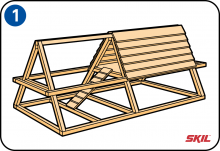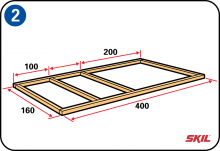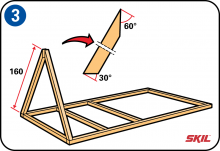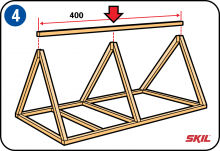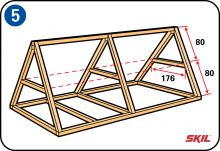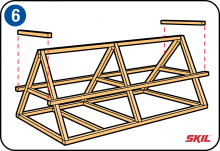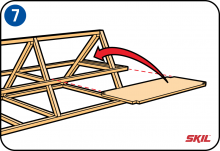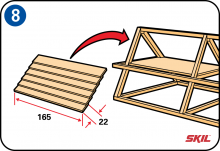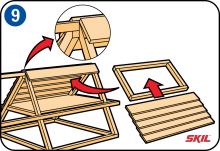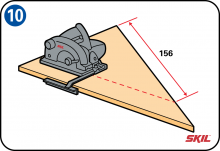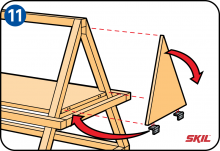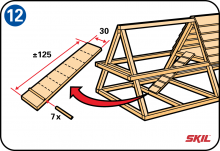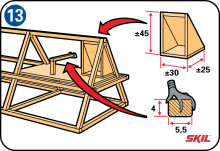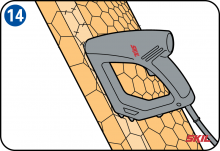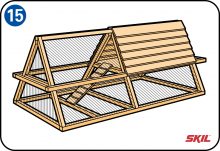-
Construction drawing for the chicken coop
This A-frame chicken coop accommodates 3 or 4 hens. The length you choose depends on the number of hens you want to keep. Use weatherproof outdoor wood, preferably FSC approved grade. This has environment-friendly impregnation, so no further treatment is needed. Waterproof plywood, shuttering plywood and impregnated wood are a good choice.
-
The basic frame
The first step is to assemble the frame of the henhouse. Make the frame as shown in the drawing out of 44x44 mm bars. To prevent the wood from splitting when screwing it together, it’s best to pre-drill all the screw holes first.
-
A-frame supports
The A-frame supports are made in the shape of a triangle. Saw the base of the triangle at an angle of 60°, and saw the top of the triangle at an angle of 30°. Then fasten the bottom angles of the beams using galvanized screws, about 65 mm long.
-
Fixing the A-frame supports to the top bar
Make the frame of the chicken coop by joining the three A-frames together with the top bar. Make sure the triangles are well aligned. Use a spirit level to check that the A-frames are vertical before you fasten the top bar in place.
-
Central cross-members
Then screw the central cross-members, with a length of about 76 cm, between the A-frame supports. Use a spirit level to check that the cross-members are straight, because these have to support the floor of the shelter.
-
Supporting beams
Now we fit the long bars, which also serve as handgrips at the front and rear. Use a spirit level when fitting the long bars, and make sure the whole structure is perfectly horizontal. Then fit the horizontal supports at both sides.
-
Floor
Saw a piece of plywood – or even better shuttering plywood – to size and screw it into place to the long bars and cross-members.
-
Roof of the shelter (reach side)
Next is the rear section of the roof of the shelter. This is made of overlapping planks of 165x22 mm.
-
Roof of the shelter (front side)
The front side of the roof of the shelter serves as an entrance. First screw a plank into place at the top. Then fit a spacing block underneath it, so you can slide the roof panel under it. This makes sure the panel stays firmly in place and prevents rain from entering. For the loose roof panel, make a frame out of 75x20 cm bars, and then screw the overlapping horizontal planks into place. If necessary you can fasten the underneath of the roof using a rotating wooden block or a bolt.
-
Rear of the henhouse
Use a circular saw or a sharp hand saw. Saw the rear wall in the same triangular shape as the A‑frame support, and screw it into place.
-
Using the rear wall as a door
You can use the back panel of the shelter as an alternative entrance for the shelter. To do this, use two hinges at the underside. Then you screw the front of the roof permanently into place.
-
Steps
Make some simple steps with cross-strips which you have screwed into place, to make it easier for the hens to enter and leave the shelter. Don’t forget to pre-drill all the holes to prevent the wood from splitting. Screw the steps into place on the cross-members of the base frame.
-
Roosts
The diameter of the roosts will depend on the size of your hens. Fit the roosts about 15 cm from the floor. The roosts shouldn’t be round, because then the hens can’t sit securely. They should be square or oval in cross-section. A roost should be on average around 5.5 cm wide and 4 cm thick. Fit the widest side of the roost horizontally, so the hens have plenty of support.
Nesting box
Every chicken coop needs a nesting box. A nesting box measuring 30x30 cm and with a height of around 40 cm is big enough. Put a layer of grit inside the nesting box. That will let the hens scrape up some of the chalk out of the grit, which they need to make their eggshells while they are laying. You can also use some hay or stray, as long as you change it regularly.
-
Applying the gauze
Fix the gauze over the chicken coop and secure it with staples or tacks. Then fit some finishing strips over the gauze so you don’t hurt yourself on the sharp edges. You can also fit the gauze before the supporting bars, but this can make it difficult to fit the steps.
-
Ground cover
This chicken coop is easy to move around in the garden, which keeps the ground fresh. The best ground covering in the shelter is wood shavings, clean sand or a mixture of these. If you prefer to use straw, make sure it stays well aerated. If you spread some grain among the straw each day, the hens will keep it well aerated.

